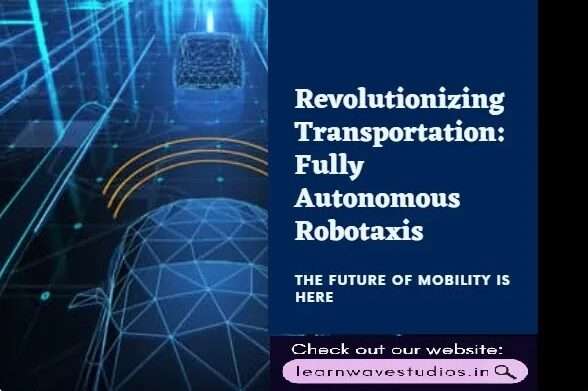The Future of Transportation: Assessing the Likelihood of Fully Autonomous Robotaxis
In recent years, the concept of fully autonomous robotaxis has gripped the imagination of the public, promising a revolution in transportation. This blog post endeavors to explore the likelihood of these autonomous vehicles becoming a reality in the near future, addressing the technological advancements, regulatory considerations, and real-world challenges in this domain. Let’s embark on an insightful journey into the potential of fully autonomous robotaxis and their impending impact on the transportation landscape.

Understanding Fully Autonomous Robotaxis
Fully autonomous-robotaxis represent a groundbreaking advancement in transportation by leveraging cutting-edge technologies such as artificial intelligence, sensor fusion, and advanced computing systems. These vehicles are designed to operate without human intervention, offering passengers a seamless and efficient mode of transportation while redefining the concept of mobility.
The pivotal advancements in artificial intelligence, machine learning, and sensor technologies have propelled the development of fully autonomous-robotaxis. These vehicles rely on complex algorithms to interpret data from various sensors, enabling them to perceive their surroundings, make real-time decisions, and navigate through diverse traffic scenarios. The continuous refinement of these technologies brings us closer to the realization of fully autonomous transportation solutions.
Regulatory Considerations
The path to integrating fully autonomous robotaxis into the fabric of everyday transportation involves navigating a comprehensive array of regulatory challenges and considerations. Regulatory frameworks, safety standards, liability concerns, and public acceptance are among the critical factors that require meticulous attention as the industry strives to actualize this futuristic vision.
While the potential of fully autonomous robotaxis is vast, there are several real-world challenges that must be addressed to ensure their successful implementation. These challenges encompass technological robustness, cybersecurity, infrastructure adaptability, and the intricate dynamics of human-robot interaction. Overcoming these challenges will be integral to the widespread adoption and acceptance of fully autonomous robotaxis.
Likelihood of Future Realization
Evaluating the likelihood of fully autonomous robotaxis becoming a reality in the near future necessitates a holistic understanding of the intricate convergence of technology, regulation, and societal readiness. While significant progress has been made, achieving a comprehensive deployment of these vehicles requires concerted efforts from industry stakeholders, policymakers, and technology innovators. The trajectory towards realizing fully autonomous robotaxis appears promising, albeit contingent on sustained dedication and collaborative endeavors.
In conclusion, the advent of fully autonomous robotaxis heralds a paradigm shift in the realm of transportation, promising unprecedented convenience, safety, and efficiency. As the technological landscape continues to evolve, the prospect of witnessing fully autonomous vehicles seamlessly navigating our cities and highways draws closer. However, acknowledging and addressing the multifaceted challenges inherent in this endeavor remains pivotal to realizing this transformative vision.
The strides made in technology, the evolving regulatory landscape, and the determination of industry pioneers collectively illuminate the potential for fully autonomous robotaxis to redefine the future of transportation. While the road ahead may be intricate, the destination holds the promise of a transportation ecosystem where fully autonomous robotaxis are an integral and ubiquitous facet, reshaping the way we perceive and experience mobility.

